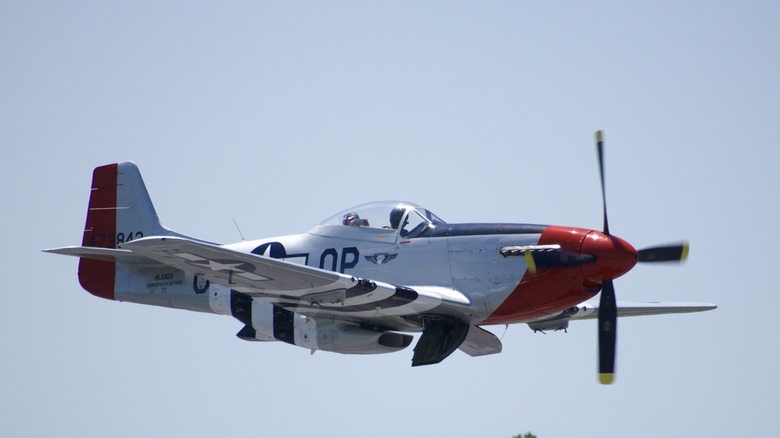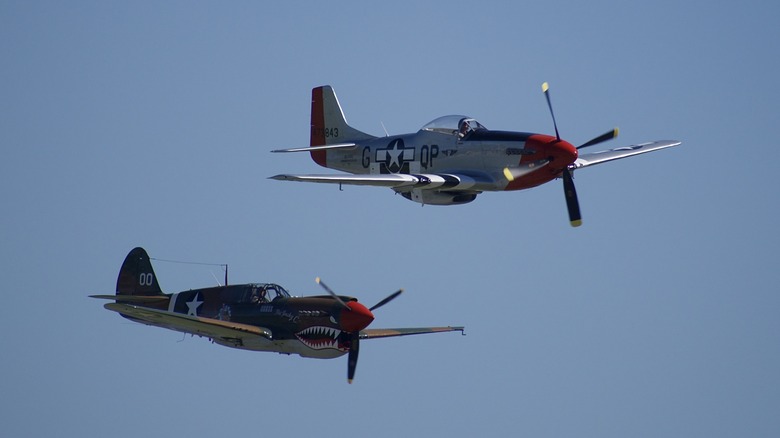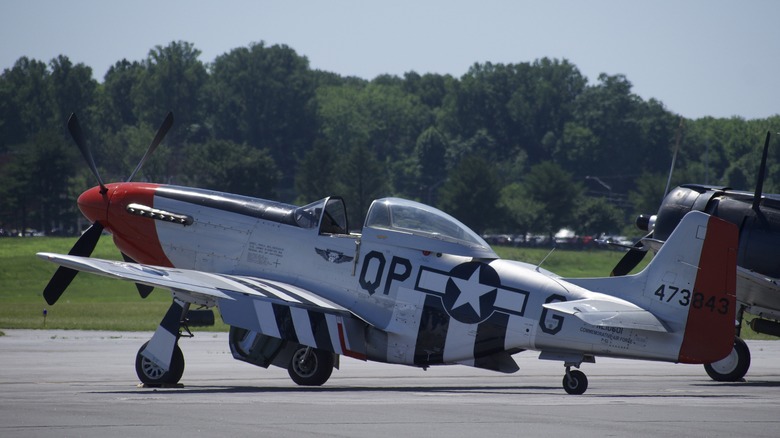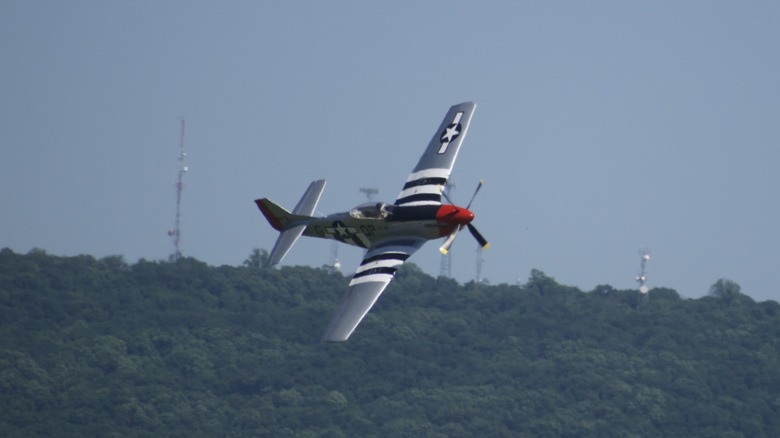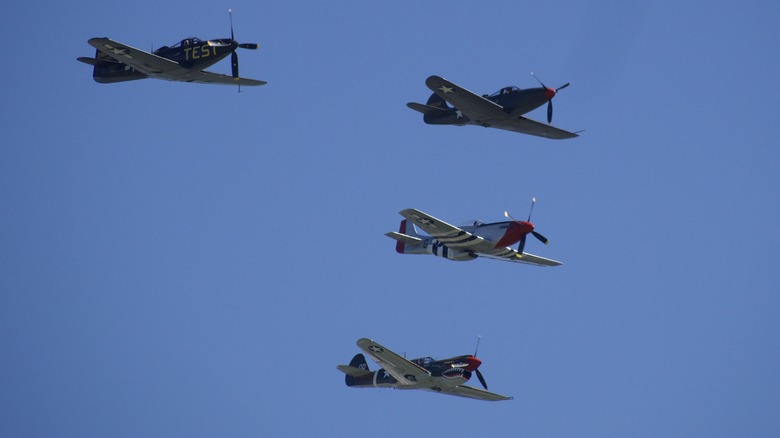The Secrets Of The Legendary P-51 Mustang And How It Dominated The Skies
Early in World War II, the Axis Powers of Nazi Germany and Imperial Japan had three distinct aircraft that were able to wreak havoc on the relatively underdeveloped air power of the Allied nations. There was the Messerschmitt Bf 109 that was able to escort German bomber planes in the Third Reich's initial blitz across Europe. As an escort and a standalone fighter plane, it made short work of many British Royal Air Force (RAF) planes, not to mention multiple planes from Poland, France, and the Soviet Union. In addition to the Bf 109, the Luftwaffe (Nazi Germany's air force) had the Focke-Wulf Fw 190 that was able to best the legendary RAF Spitfire.
In the Pacific, Imperial Japan was able to launch its Mitsubishi A6M "Zero" fighters off its then-groundbreaking fleet of aircraft carriers and assist in the Imperial Navy's scorched earth campaign all through the Pacific Islands and into China.
In the early stages of the war, going up against a Bf 109, Fw 190, or a Zero was a tough task. However, one plane, once it was at full combat readiness, outgunned, outflew, and outmatched essentially every bit of machinery the Axis threw at it. That was the North American P-51 Mustang — perhaps the best fighter of the war and quite possibly one of the most important aircraft to ever exist.
The first flight of the Mustang
The United States didn't enter the war until 1941, after the December 7th attack on Pearl Harbor by the Japanese Navy. The Mustang was first built out of a request by RAF pilots who were outmatched in the outdated Curtiss P-40 Warhawk. In 1940, less than three months after the idea was first brought up, the first ever Mustangs were produced by North American, a company that now exists as part of Boeing. The first run of Mustangs, powered by an Allison V12 was a huge improvement over the P-40, but not quite the Mustang everyone knows today.
Around two years later, RAF engineers decided to equip a Mustang with a supercharged V12 made by Rolls-Royce and designated the "Merlin" after the famed wizard of Arthurian legend. Packard, the car company, produced the engine from Rolls-Royce's design for combat ready versions of the aircraft. And the Merlin worked its magic as the P-51B, C, and later D were able to reach a top speed of 437 miles per hour, had a maximum ceiling of 41,900 feet, and a range of 1,000 miles. Those factors, combined with incredible maneuverability made the Mustang the absolute cutting edge of Allied aircraft and would prove to be the bane of many Nazi and Imperial Japanese aircraft.
Air dominance over the Third Reich
Against upgraded variants of the Messerschmitt Bf 109 in the European Theater, the Mustang was actually slower when it came to sheer top speed. But that worked to the Mustang's advantage because its superior maneuverability allowed the Mustang to get in position to fire its six .50-caliber machine guns if the Luftwaffe pilot was going too fast. When flying against the older Fw 190, the backbone of Nazi Germany's air force, the P-51 conquered handily. It could climb better, had a further range allowing it to stay in the fight longer, and had more total guns to use.
Eventually, the Mustang's individual superiority over Nazi planes became less of a factor as squadrons of bombers, escorted by Mustangs, were able to seriously cripple the Nazi war machine's abilities to produce more aircraft.
To counter the Mustang, Nazi Germany had one very big development up its sleeve, the first ever jet fighter, the Messerschmitt 262. With its jet engines, it was faster than everything else the Allied forces had seen before. For a short time, it was one of the fastest manned aircraft in existence. But with less than 300 aircraft ever leaving the factory to see fighting in any meaningful way, the Me 262 proved too little too late. It's also worth noting that Mustangs were even able to score a few air-to-air kills on the jet fighters, proving that even fancy technology couldn't beat it.
Taking out Zeros in the Pacific
In the Pacific, the Mitsubishi Zero was began to quickly show its age against the more advanced planes flying with the U.S. military including the carrier-borne Vought F4U Corsair, the Lockheed P-38 Lightning (itself a star in the European campaign where it gained the nickname the "Fork-Tailed Devil") and the P-51 Mustang. The real thorn in the side of the Zero was the Corsair which was able to score an mind-boggling 11 to one kill ratio against Japanese aircraft in the Pacific. But in any fight against the Mustang, the comparatively ancient Zero was quickly dealt with.
Where the Mustang really proved its worth in the Land of the Rising Sun was as a bomber escort. The island-hopping campaign by the U.S. gave Allied Forces more real estate to build air fields from which to launch bombers and Mustangs to strike the Imperial Japanese home islands. As the war neared its end, the once formidable Imperial Japanese Navy was sunk and rendered a large series of impromptu artificial reefs. After incurring heavy losses at the hands of Allied fighters, there was a severe shortage of pilots and planes, rendering the Zero nonthreatening.
The most perfect plane in existence
All told, the Mustang is responsible for the forcible retirement of 4,950 Axis planes over the course of the war. It was once called "the most aerodynamically perfect pursuit plane in existence" by the Senate in 1944. Given its service record, that's a fair assessment. The Mustang continued to serve in the Korean War but became quickly outclassed in the new jet age before being retired entirely in 1957. U.S. Air Force Brig. Gen. Chuck Yeager, the man who would break the sound barrier in 1947 was a noted pilot of the Mustang during the war and was even responsible for downing an Me 262 jet fighter.
The P-51 has possibly one of the most illustrious service records of any aircraft that was ever produced and played a substantial part in ensuring air dominance in the skies of Europe and the Pacific Theater. Air superiority fighters like the F-22 Raptor may keep the skies safe from Chinese spy balloons and UFOs today, but the Mustang kept the skies free of everything else when it screamed through the air in World War II.
